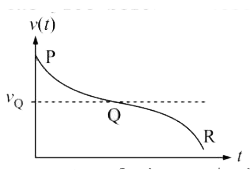Two point charges −qand+q are located at points (0,0,−a)and(0,0,a) respectively. The potential at a point (0,0,z), where z>a is
The plot below represents schematically the variation of beat frequency with time 
vP+vR=2vQ
The plot below represents schematically the variation of beat frequency with time 
The rate of change in beat frequency is maximum when the car passes through Q
The correct Answer is:A, B, D
Sped of car, V=60km/h
5003m/s
At a point S,between P & Q
vm=vm(c+vcosθc),vn=vn(v+vcosθc)
⇒△v=(vn−vn)(1−vcosθc)
similarly between Q & R
⇒△v=(vn−vn)(1−vcosθc)
d(△v)dt=±(vn−vn)vcsinθdθdt
θ≈0∘ at P & R as they are large distance apert
⇒ slope of graph is zero
at Q,θ=90∘
⇒sinθ is max
also valued of dθdt is max
as dθdt=vx where V is its velocity and r is length of kine joining P & S
and r is minimum at Q
⇒ slope is maximum at Q
⇒ (A) & (B) are correct
At p,△v=(vn−vn)(1+vc)(θ=0∘
At R, △v=(vn−vn)(1−vc)(θ=0∘
At Q, △v=(vn−vn)(θ=90∘)
⇒△vp+△vR=2(vn−vn)=2△vQ Hence (B) is correct.

Topper's Solved these Questions
- WAVE MOTIONBOOK - VMC MODULES ENGLISHCHAPTER - WAVE MOTIONEXERCISE - JEE ADVANCED ARCHIVE LEVEL 2 (PARAGRAPH TYPE)
6 Videos
- WAVE MOTIONBOOK - VMC MODULES ENGLISHCHAPTER - WAVE MOTIONEXERCISE - JEE ADVANCED ARCHIVE LEVEL 2 (MATRIX MATCH TYPE)
3 Videos
- WAVE MOTIONBOOK - VMC MODULES ENGLISHCHAPTER - WAVE MOTIONEXERCISE - JEE ADVANCED ARCHIVE LEVEL 2
32 Videos
- UNITS, MEASUREMENTS & ERRORSBOOK - VMC MODULES ENGLISHCHAPTER - UNITS, MEASUREMENTS & ERRORSEXERCISE - IN - CHAPTER EXERCISE - B
10 Videos
- WORK ENERGY AND POWER BOOK - VMC MODULES ENGLISHCHAPTER - WORK ENERGY AND POWER EXERCISE - IMPECCABLE
54 Videos
Similar Questions
Two point charges −q and +q are located at points (0,0−a) and (0,0,a) respectively. The electric potential at point (0,0,z)is (Z>a)
View SolutionTwo point charges q and - q are located at points (0 , 0 , - a ) and (0 , 0 , a) respectively :
(a) Find the electrostatic potential at (0 , 0 , z) and ( x, y , 0).
(b) How much work is done in moving a small test charge from the point (5 , 0 , 0 , ) to (-7 , 0 , 0 ) along the x - axis ?
(c) How would your answer change if the path of the test charge between the same points is not along the x axis but along any other random path ?
(d) If the above point charges are now placed in the same position in a uniform external electric field →E , what would be the potential energy of the charge system in its orientation of unstable equilibrium ? Justify your answer in each case .
View SolutionTwo point charges q and –q are at positions (0,0,d) and (0,0, –d) respectively . What is the electric field at (a,0,0 ) ?
View SolutionTwo point charges q and –q are at positions (0,0,d) and (0,0, –d) respectively . What is the electric field at (a,0,0 ) ?
View SolutionWhere are the point: (0,0,−4)
View SolutionPoint charges +4q,−q and +4q are kept on the x-axis at points x=0,x=a and x=2a respectively, then
View Solution(i) Can two equaipotential surfaces intersect each other ? Give reasons
(ii) Two charges −qand+q are located at point A (0, 0 -a) and B(0, 0, +a) respectively. How much work is done in moving a test charge from point P(7,0,0) to Q(−3,0,0) ?
View SolutionTwo fixed charges −2Q and +Q are located at points (−3a,0) and (+3a,0) respectively. Then which of the following statement is correct?
View SolutionTwo point charges +q and -q are held fixed at (−a,0) and (a,0) respectively of a x-y coordinate system then
View SolutionTwo point charge −q and +q/2 are situated at the origin and the point (a,0,0) respectively. The point along the X-axis where the electic field Vanishes is
View Solution
